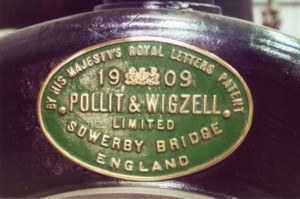

I am indebted to Ray Wigzell for most of this information.
Pollit & Wigzell of Sowerby Bridge, Yorkshire was a well-
The company was founded by Timothy Bates in 1786 and was known as Timothy Bates & Co. at Bank Foundry, Sowerby Bridge, Yorkshire. In 1834 the founder’s grandson, Joseph Pollit, took over from his uncle, George Bates. For a time, Joseph Pollit (1813 -
When Edward died in 1857 Joseph continued to run things and he bought the company in 1862. Three years later, in 1865, Eustace Wigzell joined Joseph and together they took the company to international prominence and made it one of the foremost in the country.
In 1892 the company was rapidly extended and converted to a private limited company, under the name of Pollit & Wigzell, with Joseph as chairman and Eustace as managing director.
Eustace died in 1899 aged 77
Joseph died in 1900 aged 87
Another uncle and nephew partnership, Edward Pollit and John Waterhouse Pollit, ran the company up to the time of liquidation in 1930
At its height the firm employed around 400 men and occupied an area of 4 to 5 acres at Bank Foundry. No records are available to tell how many engines were produced, but the total probably exceeded 1000.
Inevitably the company became a victim of the decline in the textile industry and the increasing competition from electrical power, which resulted in the demand for large steam engines drying up. During this period many of the mills converted to electrical power and some of the engines existing in the mills were adapted to drive the electrical generators.
Sadly, in 1930, the company went into voluntary liquidation and the foundry was demolished in 1937.
—-
Notes from obituaries in various engineering journals.
It is with great regret we learn of the death, on the 2nd inst. of Mr. Eustace Wigzell, in his seventy-
He was born at Greenwich in 1822, his father being a captain in the East India service, and his mother the third daughter of the late General Rimington.
That he had an early inclination for mechanics is proved by the fact that when at school he won a prize, given by the Greenwich Observatory authorities, for a design for signaling the time and his idea was adopted. He served five years as an apprentice engineer at Penn’s, beginning with his fifteenth year, and subsequently worked for two years as a journeyman.
He was appointed chief engineer to the Russian Government Engineering Works at Ekateringburg, in the province of Perm, and after carrying through various works in connection with marine engineering, mining, etc., he came to England in 1854 to secure a plant for the manufacture of railway bar iron. Whilst in England, war was declared, and although liberal offers were made by the Russian Government, he did not return.
At John Penn’s personal request he rejoined the firm of John Penn and Sons. He remained there until 1865 and it was during this period that steam power was introduced so largely into war ships, the trunk engine being largely adopted. Then, also, the screw propeller was first fitted.
This work especially suited Mr. Wigzell’s mechanical skill and he had the superintendence of the construction and trials of nearly two-
It was in 1865 that he joined Joseph Pollit, of Sowerby Bridge, who was carrying on the business of general engineer, under the title of Timothy Bates & Co. He soon adapted his experience for this new class of work and the firm early established a reputation, especially for stationary steam engines.
In the year 1892, the firm was converted into a limited liability company and until his death he was managing director. In spite of his advancing years he continued to maintain the keenest interest in the works and modern improvements.
He was a member of the Institute of Mechanical Engineers and was elected a member of the Iron and Steel Institute in 1881.